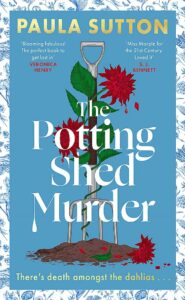Hill House Vintage Murder #1
 One of the most interesting things about The Potting Shed Murder is that readers get to experience the inner thoughts and perspectives of most of the characters involved in the story. Instead of just experiencing how the detective, in this case a Daphne Brewster, thinks, readers get to see how the other townsfolk view one another and react to the murder. Daphne and her family are brand new to the English county village of Pudding Corner and are thus under a lot of scrutiny from the community. She is also one of the very few black members of this community, and is fully aware that means she is getting perhaps a bit more scrutiny than another new neighbor might. Even so, Daphne is determined to make a life in Pudding Corner after leaving the rather intense and expensive life of London behind.
One of the most interesting things about The Potting Shed Murder is that readers get to experience the inner thoughts and perspectives of most of the characters involved in the story. Instead of just experiencing how the detective, in this case a Daphne Brewster, thinks, readers get to see how the other townsfolk view one another and react to the murder. Daphne and her family are brand new to the English county village of Pudding Corner and are thus under a lot of scrutiny from the community. She is also one of the very few black members of this community, and is fully aware that means she is getting perhaps a bit more scrutiny than another new neighbor might. Even so, Daphne is determined to make a life in Pudding Corner after leaving the rather intense and expensive life of London behind.
Determined to integrate herself, she opens up a shop restoring vintage furniture as well as customizing paint jobs for specific pieces upon request. She even gets the nickname ‘the vintage lady’ around town fairly quickly. She also has a daughter, Imani, and twin sons, Archie and Fynn, so meeting up with fellow parents and school staff also embeds her further into the community – except with one mother. This single mom of a boy her kids befriend is seen as an outcast due to living in a commune on the edge of town amongst other likeminded women, even though she has always lived in town. The other school mothers warn Daphne to stay away from her, and keep her kids away from her son, lest she become a social pariah. Fortunately, Daphne refuses to ostracize someone just because of social peer pressure and she quickly becomes friends with her.
When the headmaster of the school is found dead, the whole town is in disarray. Daphne is happy to stay out of things until her new friend is pointed at as suspect number one by the headmaster’s wife, and she’s then determined to clear her name. Her husband is less than supportive about her endeavors, but that doesn’t stop her. Nor does the annoyed Inspector Hargreaves, who would like nothing more than for her to keep her nose out of things. He does not ignore information or clues she brings him, but he is quite patronizing and refuses to let her think that she is helping in any way. Secrets and intrigue abound as decades of drama surrounding the headmaster and his life are uncovered, leaving Daphne with too many suspects and too little hard evidence.
The alternating perspectives and internal monologs allow readers to experience The Potting Shed Murder from several different angles. This is a very tricky technique to pull off effectively and Paula Sutton did an excellent job balancing the other character’s chapters with our heroine Daphne’s. It raises tension for readers as they can see clues and possible motives that it takes Daphne a little longer to uncover. I suggest The Potting Shed Murder for anyone who prefers to see the internal monologs of characters, allowing readers to really relate and understand them on a more personal level. – Carla Schantz